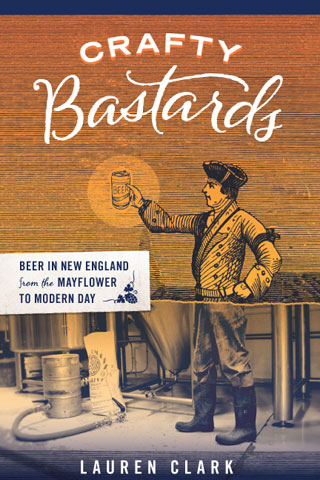March 3rd, 2011
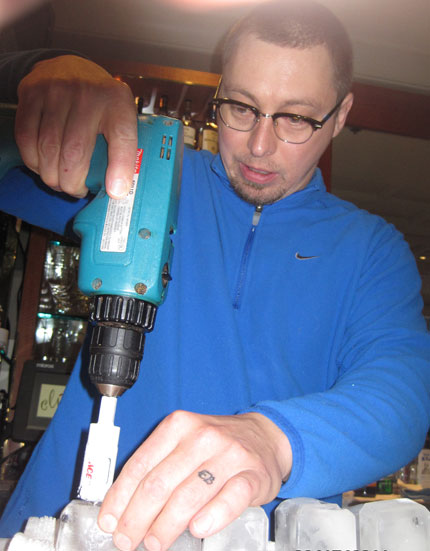
Bartender profile
Much of the Boston fine-dining scene still neglects to put the kind of pizzazz into the bar that comes out of the kitchen. Todd Maul is changing that. With his tattooed forearms, Mercury-era NASA spectacles and tendency to recite from Embury’s The Fine Art of Mixing Drinks, he doesn’t seem like the kind of guy you’d find behind the slab at one of the city’s more haute dining rooms — Ken Oringer’s Clio. But he has in fact put that little bar on the map as a destination for serious and inventive cocktails.
I first met Todd when he was honing his chops and trying to sneak vintage potions like the Lion’s Tail onto the drink menu at Rialto, in Cambridge’s Charles Hotel. When his efforts hit a wall, he moved to Clio, where he steadily gained creative license. Chef Oringer told him, “If you can think it up, and it tastes good, do it”– oh, and don’t be afraid to raid the kitchen. With that mandate, Maul does things like “use ice as a garnish.” For gin and tonics, he’ll deposit loomi — dried Middle Eastern black lime — into patterns he drills on square cubes (see above), or he’ll put a cylinder of violet-infused ice in a Todd Collins (Old Tom & Old Raj 110 gins, lemon, seltzer, Benedictine-soaked cuke) so that it slowly turns your drink bright blue while you sip. In the past couple of years, Clio has gone from a brief list of mostly vodka-based mixtures that blended into the background to a fun, 80-item menu (with retro font and graphics) of both faithful and fanciful interpretations of classic recipes. It’s like an album of Great American Songbook standards, some sung by Frank Sinatra and others sung by Bjork.
Maul’s other passion is furniture making; he studied the craft at the prestigious North Bennet Street School. He compares knowing various types of wood and how to build a table with them to knowing, for instance, different types of whiskey and how to build a cocktail with them. “Had I not gone [to North Bennett Street], I probably wouldn’t have paid attention to bartending the way I did. It’s a trade — you’ve got to work at it.”
Hometown
Kinderhook, NY.
Past bartending jobs
Rialto, Boston Park Plaza, Four Seasons.
First drink you ever had
Genessee beer. It’s an upstate New York thing.
Favorite bar in Boston other than your own
No. 9 Park. I have always liked what they do there.
The drink you most like to make
One for a regular.
The drink you least like to make
The first/last drink for someone that you know is going to be a problem.
What you drink at the end of your shift
PBR tallboy.
If you weren’t a bartender, you’d be…
A furniture maker. My shop misses me.
Most beloved bartending book
If you’ve ever sat at my bar you already know: David Embury’s Fine Art of Mixing Drinks.
The best thing about tending bar in a fine dining setting is…
The conversations (it’s a little more mellow, so you can actually hear the person across from you), and seeing the milestone events in people’s lives.
The worst thing about tending bar in a fine dining setting is…
People can be intimidated by what they perceive as the culture in these restaurants.
People drink too much ________
What I call “lifestyle beverages” — when someone orders marketing, not booze.
People don’t drink enough ________
Old Raj 110.
Unlikely drink for a cold winter night
Dr. Cocktail.
The best thing about drinking in Boston is…
I can get a drink from Joe McGuirk somewhere where they don’t mind if my kid throws something on the floor.
The worst thing about drinking in Boston is…
That you can get spoiled by the other people on this list, and realize that they only work in Boston. The standard they set doesn’t always travel.
Permalink | 10 Comments | Filed under Bartenders, Cocktails | Tags: Clio, Ken Oringer, Todd Maul
February 16th, 2011
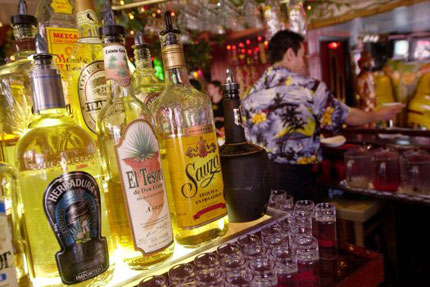
When it comes to tequila, I plead ignorance. If I’m lucky to be in the hands of a knowledgeable bartender or agave enthusiast, I happily let him/her guide me toward whatever’s right for a given cocktail (be it a traditional margarita or a Jaguar) or neat nightcap with beer chaser. But when I find myself confronting, without a lifeline, that overgrown jungle of tequila bottles on the back bar of your modern-day high-end Mexican restaurant, I balk — especially when the bartender can only describe what’s in each bottle with various synonyms for “awesome.”
So I asked a few experts to break things down for me: Misty Kalkofen, Drink bartender and cocktail consultant who has studied agave spirits extensively; Andrew Deitz, sales rep with the wine and spirits wholesaler M.S. Walker; and Phil Ward, owner of the NYC tequila bar Mayahuel.
First, it’s widely agreed among spirits aficionados that 1) only rubes drink Cuervo Gold — a mass-marketed “mixto” (a mix of agave-based spirit and neutral alcohol akin to rum) masquerading as premium hooch — and 2) only poseurs drink Patron, which pioneered the premium-tequila category but is now an overpriced shadow of its former self.
Kalkofen says that the Cuervo, Patron, Sauza, Herradura and Don Julio brands make up about 90 percent of the U.S. tequila market. Patron, she adds, was a distinctive tequila when it was produced by the Siete Leguas distillery in the 1990s. But in 2002 the brand opened its own distillery, which now produces a smooth but unremarkable tequila whose price tag ($50 for añejo) is based entirely on its earlier legacy and classy corked bottle. Deitz, who recently advised the new Fort Point cantina Papagayo on its extensive tequila selection, says he would choose, for instance, the very reasonably priced Lunazul Blanco ($25) over Patron.
Sauza, of course, can be found in the well of any bar that bangs out margaritas of the frozen-strawberry or sour-mix-in-a-pint-glass variety. And if you thought Don Julio and Herradura were artisanally legit, think again — they’ve reportedly both been dumbed-down by their fairly new owners, the liquor conglomerates Diageo and Brown-Forman, respectively.
The hot growth in demand for 100-percent-agave tequila has attracted large producers and their often corner-cutting ways, and a lot of trusted brands are changing. “Good tequila is a dying breed,” laments Ward, who points to Herradura as a case in point. “Herradura is the saddest story in the world,” he says. The once-family-owned distillery produced a sizable quantity of reasonably priced, quality spirit. But Brown-Forman replaced the traditional method of extracting agave sugars — slowly roasting whole agave hearts, or piñas, in a large oven — with diffusers, in which the piñas are shredded raw before being “basically microwaved,” says Ward.
In a good tequila, Kalkofen says she is “looking for roasted agave flavor. With a diffuser, the flavor gets watered down.” Of course, that “watered down” flavor is exactly what many new labels hoping to cash in on the premium-tequila market are going for. A bland spirit in a nice bottle is intended to win over the brand-conscious vodka drinker.
Connoisseurs tend to judge a brand of tequila by its unaged version, e.g. blanco, silver or plata. Reposados (aged 2-11 months) and añejos (aged 1-3 years) “are only as good as the juice being put in the barrel,” says Kalkofen. Deitz agrees that wood-aging, while important, is not as big a deal as either the production process or the terroir — whether the agave comes from the highlands or lowlands, or from the primary tequila producing region of Jalisco vs. the lesser-known Tamaulipas. As for the extra-añejo classification (aged more than 3 years), Deitz says, “It can be a bullshit category, as many of the uber-expensive bottlings are actually artificially flavored.”
So, what brands do these connoisseurs recommend to people who are looking for good-quality, flavorful tequilas? Here’s your cheat sheet, amigos, with prices for each brand’s blanco and some helpful tasting and terroir notes thrown in by Deitz:
- Chinaco ($50) – from Tamaulipas. Briny, citrusy.
- Don Roberto ($47) – masculine, powerhouse style.
- El Tesoro ($49) – highland tequila, known for high acidity and aromatic, herbal components.
- Lunazul ($25)
- Milagro ($25)
- Ocho ($55-$70) – producer of unusual single-vintage tequilas.
- Partida ($41) – lowland tequila, known for round, rich fruit character.
- Pueblo Viejo ($28)
- Siembre Azul ($35)
- Siete Leguas ($36) – highland tequila, known for high acidity and aromatic, herbal components. Highly regarded in Mexico.
Permalink | 21 Comments | Filed under Tequila | Tags: agave
January 21st, 2011
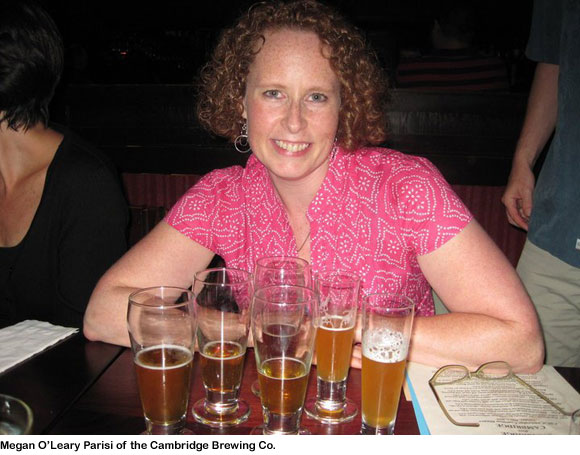
Today, three women will undertake what appears to be the first collaboration of female brewers. Megan O’Leary Parisi of our local Cambridge Brewing Co., Whitney Thompson of Victory in Pennsylania and Laura Ulrich of Stone in California will gather at the CBC to make a Belgian dubbel-style ale that they have labeled Project Venus. Cool, eh?
OK, all you medieval history buffs out there know it’s probably not the first collaboration. In the Middle Ages in England, brewing was women’s work, and the women who made beer were called brewsters. No doubt they joined forces from time to time. As Judith M. Bennett writes in Ale, Beer and Brewsters in England: Women’s Work in a Changing World, 1300-1600:
“Women once brewed and sold most of the ale drunk in England, and since ale was, as we shall see, drunk in vast quantities, women had to produce and market it in vast quantities as well. Today, most aspects of the brewing trade … rest largely in the hands of men. Women’s work has now become men’s work. When did this happen? Why? With what effect?”
To answer that last question…
Uh, yeah. Bring on the Project Venus, ladies. The three brewsters hatched the collaboration while hanging out in Denver during the Great American Beer Festival last fall. They’ll take the rich, malty, dried-fruit character of a classic dubbel and add a few twists, such as oranges, orange-blossom honey and saffron (!). Parisi, who has been brewing at the CBC since 2006, expects to tap the beer toward the end of February.
Long live the brewster tradition!
Permalink | 1 Comment | Filed under Beer | Tags: cambridge brewing co., Laura Ulrich, Megan O'Leary Parisi, Project Venus, stone brewing co., victory brewing co., Whitney Thompson
January 17th, 2011

Hey! I’m an “ultimate insider” in the MSN website’s new “Rediscover…” series of travel videos profiling 12 U.S. cities. In the intro to the Boston videos, three other insiders and I gather for pints at Doyle’s in Jamaica Plain and gab about our fave spots in greater Beantown. Then, we splinter off into four separate vignettes where each of us pairs up with another Bostonian and drives a Buick (the series’ sponsor) to different neighborhoods. Here’s the one I’m in with Harvard archivist and Boston Typewriter Orchestra member Giordana Mecagni.
The other Boston insiders are Fenway Park DJ (and sometime drinkboston drinking buddy) TJ Connelly, butcher and fishmonger Michael Dulock of Concord Prime & Fish, and Kupah James, a hiphop dancer, DJ and mentor to teen boys. The videos jam lots of noteworthy places and things, both touristy and un-touristy, into just a few minutes: East Boston (the Zumix performance space, the Boston Typewriter Orchestra, Piers Park, Santarpio’s Pizza, Scups), downtown (Union Oyster House, Boston Athenaeum, Stoddard’s, Bond) Back Bay/South End (Casa Romero, the Otherside Cafe, Darrell’s Corner Bar, Wally’s), Inman Square (East Coast Grill, Trina’s Starlite Lounge, Olé), Concord (Concord Prime & Fish, Main Streets Market, Concord Barber Shop), Jamaica Plain (Salmagundi hat shop, Vee Vee, Ten Tables, Doyle’s) and Fenway Park, to name a few.
The experience gave me an appreciation for the skill with which professional video producers boil an entire weekend of shooting into just a few informative, lively minutes. My favorite behind-the-scenes moment was showing up at the Union Oyster House in the middle of an autumn Saturday lunch rush with a crew of about 10 (producer, a couple camera guys, a sound guy, a photographer, assistants, etc) and nonetheless being politely expedited to a table where we filmed a conversation amid the hubbub. And I got to fulfill my lifelong dream of sucking down a raw oyster on camera.
Permalink | 4 Comments | Filed under drinkboston in the news, Video | Tags: insider, Kupah James, Michael Dulock, MSN, TJ Connelly, travel, video
January 6th, 2011
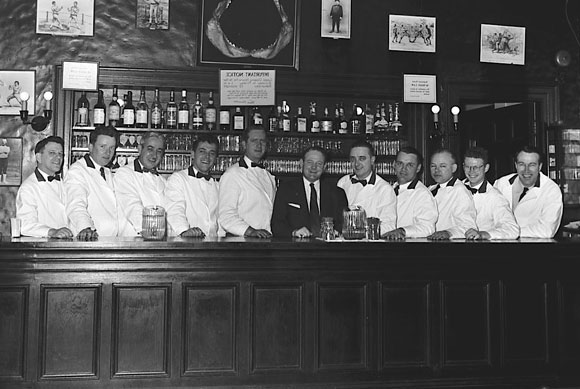
Don’t get the wrong idea from this vintage photo in the Boston Public Library’s print & photograph collection: women are well represented behind Beantown bars, and they and their male counterparts are getting organized.
First, our city’s own chapter of the U.S. Bartenders Guild will soon be official. Corey Bunnewith of Citizen Pub, Kirsten Amman of LUPEC Boston, Alex Homans of Russell House Tavern and Rob Hoover of Upstairs on the Square are helming this effort, which right now involves finding at least 40 members with $100 for annual dues to sign on. Meanwhile, April Wachtel, bar manager of the solid new South End restaurant & bar The Gallows, has started a less formal, local (and, for now, free) concern called the Boston Bartenders Collaborative.
I never knew the USBG existed before the craft cocktail movement got going. It was founded way back in 1948, and it’s affiliated with the 50-country International Bartenders Association, itself established in 1951. USBG sponsors seem to include every spirits conglomerate known to man — Pernod Ricard, Bacardi Ltd., William Grant, etc. — as Jonathan “Cocktail Guru” Pogash indicates in his summary of a recent field trip to Boston to help spark the USBG chapter here. Bunnewith says that although these companies obviously aim to promote their brands by sponsoring Guild events, they impose no restrictions on the use of spirits from lesser-known producers.
The four USBG-Boston officers mentioned above hosted a Pernod Ricard-sponsored meet & greet just before Christmas at Russell House Tavern to drum up interest, and several bartenders and others related to the industry (including this blogger) turned out. Lucky for me and a few others around town: we get our first year’s dues waived for having successfully completed the BarSmarts program. (The USBG has different membership categories, one of which is for people who aren’t actually bartenders.)
Why should you join? One reason is career advancement. “As the Guild gains a reputation in Boston, employers will recognize that members are knowledgable and passionate about alcoholic beverages and the operations of a bar,” says Bunnewith. The USBG also has an accreditation program that is recognized worldwide, in case you decide to pack your bar tools and move to Bratislava. Other perks include product-education classes, events, the occasional field trip and invitations to participate in cocktail competitions (i.e. create cocktails for liquor companies for free as you vie to win a cool trip). In earnest, the chance to network, taste product, and go to fun events with others who take the profession seriously seem to me like excellent reasons to get involved.
Those are the same reasons people in the local biz should take a look at the Boston Bartenders Collaborative. Wachtel envisions a symbiotic relationship between USBG-Boston and her grass-roots enterprise, which is focused on education and so far has about 15 volunteer participants. Most meetings take place in one of the members’ bars during a weekday. The next one, at Craigie on Main January 10, will feature John Mayer of Craigie and Tyler Wang of Drink talking about ice and dilution in cocktails. Other topics in the works include an interactive roundtable about cocktail formulas and discussions on speed and volume, guest relations and managing inventory. (See info about participating below.)
“There’s a good part of our community that wants to learn in ways beyond just informal visits to other bars. This is a chance to build something that has never existed in Boston,” says Wachtel, adding that the Collaborative aims to “have fun and not take ourselves too seriously.”
Sure, some people might chuckle at the notion of bartenders getting together to talk about ice and inventory, but think about it: Boston barkeeps are elevating their profession and trying to create a solid talent pool in this town. I, for one, am wicked psyched about that.
For information about joining USBG-Boston, go to the group’s Facebook page or email USBGBoston@gmail.com.
Most Boston Bartenders Collaborative seminars are members-only, but select seminars will be open to the general public. To receive notifications about seminars, or for more information, email April Wachtel at april@thegallowsboston.com.
Permalink | 2 Comments | Filed under Bartenders, Books & resources | Tags: Alex Homans, April Wachtel, Boston Bartenders Collaborative, Corey Bunnewith, education, guild, Kirsten Amman, Rob Hoover, USBG





